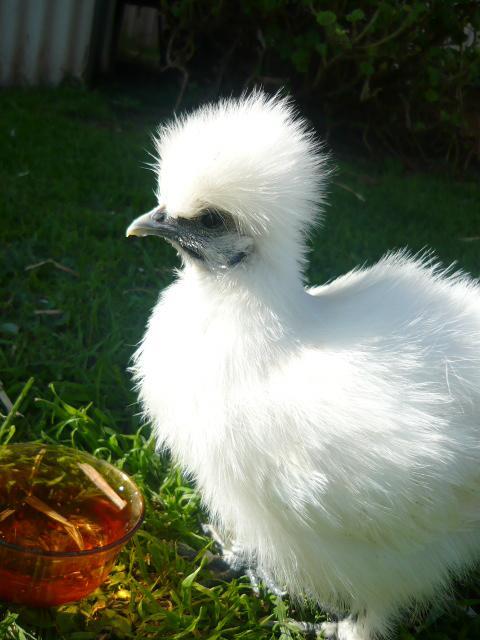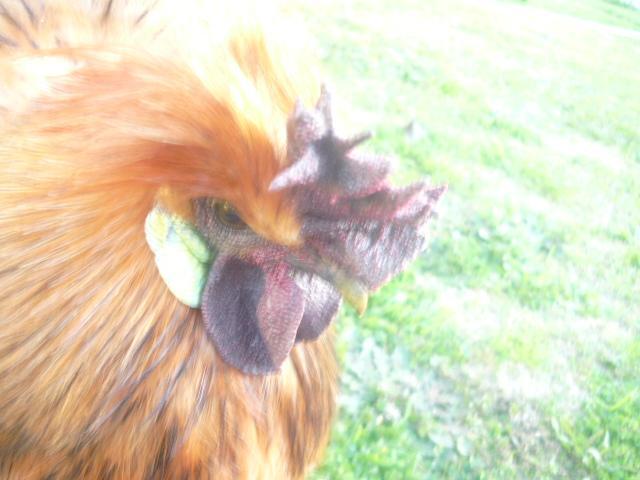This information has beened copied off a a few site. so, i hope this information is going to be helpful! if you want to keep it just copy and paste it!

http://threecedarsilkies.webs.com/allaboutsilkies.htm
The Silkie is a breed of chicken with soft, fluffy plumage and black skin. It is believed that the breed originated in China or Southeast Asia, and one of the earliest references to the Silkie appears in Marco Polo's writings, dating back to the thirteenth century. The breed was recognized in the United States in 1874, and today is one of the most popular show or ornamental breeds of chickens.
Significance
The Silkie is most likely the oldest pure breed of chicken in existence today.
Function
The Silkie is an ornamental bird, and is not typically prized for its meat because of its black or gray color. However, there is a market for their meat among some Asian cooks as they consider them a delicacy. It is a good egg layer, but not prolific as it has a tendency to become broody. Behaviorally, Silkies are very good mothers, often used for incubating or hatching eggs of other fowl. The saying goes about Silkie hens..."They will hatch anything that comes in a shell".
Types
The Silkie is a Bantam chicken, and comes in two varieties, bearded and non-bearded. Additionally, there are several color variants that are common in the breed: black, buff, blue, gray, splash, white and partridge.
Considerations
Many believe that they don't do well in extreme temperatures, but this is overstated. They don't mind the cold...as long as they are not wet. Because of the lack of "barbicels" that cause feathers to form in typical chickens, their feathers are not water resistant.
Silkies are particularly known for their sweet dispositions and affinity for humans. Because of this, they make wonderful pets!
Features
All Silkies have five toes. They have a small mulberry colored walnut comb and wattles, turquoise earlobes, black skin and bones, and grayish-black meat. They lay buff- or cream-colored eggs. Their feathers lack barbicels and are similar to down. Because of their fluff rather than feathers, they cannot fly. They tend to prefer to sleep in "silkie piles" on the floor of the coop rather than roost.
Size
Silkies hens generally weigh between 1 1/2 and 2 1/2 lbs. Roosters are a bit larger at between 2 1/2 and 4 pounds.
____________________________________________________________________________________________________
http://www.feathersite.com/Poultry/CGP/Silkies/BRKSilkies.html
There are lots of pictures of different silkies on this site. it is very informative! Probably you will be silkied out by the time you have seen all the pictures!

This breed was developed in the Orient, probably in Japan. The feathers don't have barbs or quills, and the birds look and feel like Persian cats! Some of the varieties are Black, Blue, Buff, Partridge, Silver-grey and White. Interesting characteristics of the breed are its 5 toes and black skin. They also have walnut combs, which should be a deep mulberry approaching black. Red comb and wattles are disqualifications. Silkie hens are among the best to use as broodies if you want to hatch your eggs out under hens. They make wonderful mothers and I've known a silkie rooster to steal a brood of very young chicks and raise them himself -- this is a very nurturing breed!
____________________________________________________________________________________________________
http://www.mypetchicken.com/chicken-breeds/Silkie-Bantam-B100.aspx
Silkie Bantam
Of all the ornamental chicken breeds, the Silkie Bantam is one of the most popular and beloved, and certainly one of the most entertaining to watch. Can't you tell why? They're the lap kitty of the chicken world, complete with hair-like plumage and an incredibly sweet temperament. We have heard it said that Silkies are like a "flock" of kittens... but unlike your other pets, your chickens can actually provide your breakfast! Silkies originated in the Far East, where they are still kept (and eaten) today. They have black skin and bones and 5 toes instead of the normal 4. In addition, Silkie hens make wonderful brooders and mothers, and are even known to adopt baby ducks if given the chance!
Origins/History
Class: Feather-legged Bantam
Type: Bantam
Size: Bantam
Rarity: Common
Purpose: Ornamental
Recognized Varieties: Bearded & Non-Bearded: Black, White, Partridge, Buff, Gray, Blue
Egg Facts
Egg Laying: Good (3/wk)
Egg Color: Cream or Tinted
Egg Size: Tiny (bantam)
Fancy Features
Comb Type: Walnut Comb
Crested: Yes
Feathered Legs: Yes
Number of Toes: 5
Sutability to Backyard Life
Hardy In Winter: Yes
Bears Confinement: Bears confinement well, though no animal should be kept in small area's for long periods of time.
Especially Docile: Yes
Setter/Broody: Yes
Personality: Sweet, tame, mothering.
Thank You all and i hoped you enjoyed it!


http://threecedarsilkies.webs.com/allaboutsilkies.htm
The Silkie is a breed of chicken with soft, fluffy plumage and black skin. It is believed that the breed originated in China or Southeast Asia, and one of the earliest references to the Silkie appears in Marco Polo's writings, dating back to the thirteenth century. The breed was recognized in the United States in 1874, and today is one of the most popular show or ornamental breeds of chickens.
Significance
The Silkie is most likely the oldest pure breed of chicken in existence today.
Function
The Silkie is an ornamental bird, and is not typically prized for its meat because of its black or gray color. However, there is a market for their meat among some Asian cooks as they consider them a delicacy. It is a good egg layer, but not prolific as it has a tendency to become broody. Behaviorally, Silkies are very good mothers, often used for incubating or hatching eggs of other fowl. The saying goes about Silkie hens..."They will hatch anything that comes in a shell".
Types
The Silkie is a Bantam chicken, and comes in two varieties, bearded and non-bearded. Additionally, there are several color variants that are common in the breed: black, buff, blue, gray, splash, white and partridge.
Considerations
Many believe that they don't do well in extreme temperatures, but this is overstated. They don't mind the cold...as long as they are not wet. Because of the lack of "barbicels" that cause feathers to form in typical chickens, their feathers are not water resistant.
Silkies are particularly known for their sweet dispositions and affinity for humans. Because of this, they make wonderful pets!
Features
All Silkies have five toes. They have a small mulberry colored walnut comb and wattles, turquoise earlobes, black skin and bones, and grayish-black meat. They lay buff- or cream-colored eggs. Their feathers lack barbicels and are similar to down. Because of their fluff rather than feathers, they cannot fly. They tend to prefer to sleep in "silkie piles" on the floor of the coop rather than roost.
Size
Silkies hens generally weigh between 1 1/2 and 2 1/2 lbs. Roosters are a bit larger at between 2 1/2 and 4 pounds.
____________________________________________________________________________________________________
http://www.feathersite.com/Poultry/CGP/Silkies/BRKSilkies.html
There are lots of pictures of different silkies on this site. it is very informative! Probably you will be silkied out by the time you have seen all the pictures!

This breed was developed in the Orient, probably in Japan. The feathers don't have barbs or quills, and the birds look and feel like Persian cats! Some of the varieties are Black, Blue, Buff, Partridge, Silver-grey and White. Interesting characteristics of the breed are its 5 toes and black skin. They also have walnut combs, which should be a deep mulberry approaching black. Red comb and wattles are disqualifications. Silkie hens are among the best to use as broodies if you want to hatch your eggs out under hens. They make wonderful mothers and I've known a silkie rooster to steal a brood of very young chicks and raise them himself -- this is a very nurturing breed!
____________________________________________________________________________________________________
http://www.mypetchicken.com/chicken-breeds/Silkie-Bantam-B100.aspx
Silkie Bantam
Of all the ornamental chicken breeds, the Silkie Bantam is one of the most popular and beloved, and certainly one of the most entertaining to watch. Can't you tell why? They're the lap kitty of the chicken world, complete with hair-like plumage and an incredibly sweet temperament. We have heard it said that Silkies are like a "flock" of kittens... but unlike your other pets, your chickens can actually provide your breakfast! Silkies originated in the Far East, where they are still kept (and eaten) today. They have black skin and bones and 5 toes instead of the normal 4. In addition, Silkie hens make wonderful brooders and mothers, and are even known to adopt baby ducks if given the chance!
Origins/History
Class: Feather-legged Bantam
Type: Bantam
Size: Bantam
Rarity: Common
Purpose: Ornamental
Recognized Varieties: Bearded & Non-Bearded: Black, White, Partridge, Buff, Gray, Blue
Egg Facts
Egg Laying: Good (3/wk)
Egg Color: Cream or Tinted
Egg Size: Tiny (bantam)
Fancy Features
Comb Type: Walnut Comb
Crested: Yes
Feathered Legs: Yes
Number of Toes: 5
Sutability to Backyard Life
Hardy In Winter: Yes
Bears Confinement: Bears confinement well, though no animal should be kept in small area's for long periods of time.
Especially Docile: Yes
Setter/Broody: Yes
Personality: Sweet, tame, mothering.
Thank You all and i hoped you enjoyed it!






